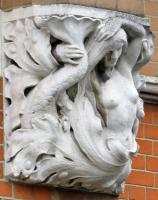
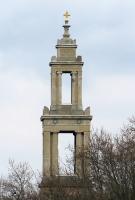
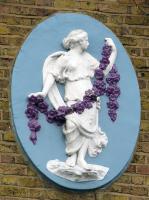
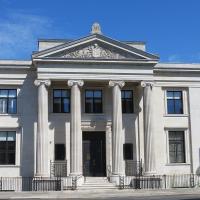
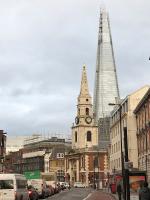
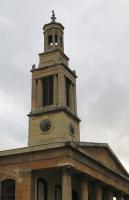
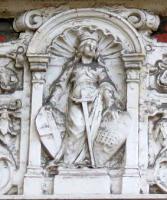
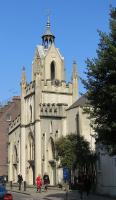
The River Thames makes an upward loop beween Waterloo and Pimlico on the west, and Depftford on the east. In the central part of the enclosed space, from Borough High Street through to Bermondsey is a walk of just a couple of miles, and if we also swing south to Walworth and Burgess Park, then for those interested in old churches and sculpture, we can make quite an interesting walk. Putting aside Southwark Cathedral, not covered here, but of course an important destination in its own right, we can cover seven good churches, and the slight remains of an eighth, of which two have fair collections of monuments, albeit rather modest panels with only a bit of sculptural decoration. The majority are of the basilica style, with pediments and pillared entrances, as if they were so many Greek temples, and then with tall Classical towers above. Statues in the area are few, but we do have three or four, and a good World War 1 memorial, and we have seven buildings from the 18th, 19th and 20th Centuries to see, with some decent architectural sculpture.
St Thomas's Church (former), St George the Martyr, both 18th Century.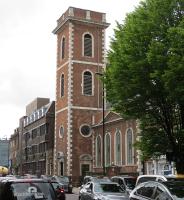
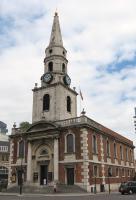
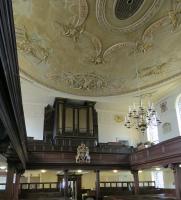
To the west, in Borough, are two 18th Century ones, the former St Thomas’s Church by Guy’s Hospital, 1700s, close to Borough High Street, made of brick and built in Romanesque style, and southwards is St George the Martyr, of the 1730s, Classical Georgian, by the architect John Price. This is visitable, and has an excellent interior, and contains around 30 mostly simple monumental panels. Just off Borough High Street nearby is Trinity Church Square, where there is the former church of Holy Trinity, put up in 1823-24, by the notable architect Francis Bedford, who designed several churches in the area. Churches in this area put up at this time are Waterloo Churches, erected in part to celebrate the defeat of Napoleon at the Battle of Waterloo.
Waterloo churches: Walworth St Peter, by John Soane, and Holy Trinity and St George Wells Way, both by Francis Bedford.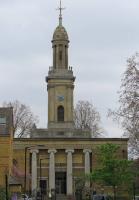
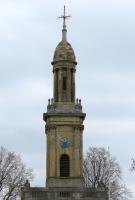
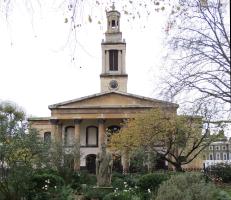
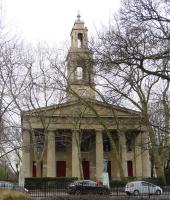
To the south is Walworth Road and Burgess Park. St Peter, Walworth Road, is by John Soane, architect to the Bank of England, another Waterloo church erected in the 1820s. It has a nice interior, beautifully painted, but just a handful of monumental panels. In Burgess Park, on Wells Way which bisects it, is the former church of St George, yet another Waterloo Church, and again by Francis Bedford; the interior has been converted into flats.
St John Horsleydown base, St Mary Bermondsey exterior, interior, and detail of a monument.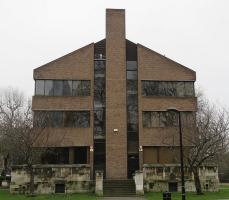
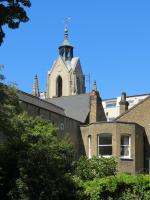
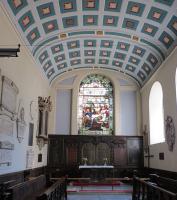
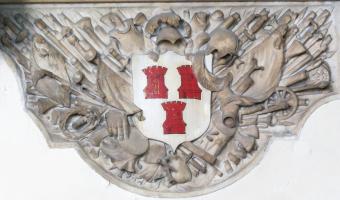
East from Borough along Tooley Street brings us to all that survives of St John Horsleydown (see bottom of this page), once an important church by Hawksmoor and John James; now only the base is left. Close by is St Mary’s Bermondsey, the building being mostly 17th to 19th Century, but the tower being medieval – our only medieval tower in the area we are looking at – Southwark Cathedral excepted. St Mary Bermondsey is also the church with the most interesting monuments inside, about 30 in all, and including a variety of 18th Century panels in rich marbles and later works.
East again we have our final Waterloo Church, St James Bermondsey, by the significant sculptor James Savage, whose most well known building is the enormous St Luke’s Church in Chelsea. It is another visitable church, with a sparse crop of simple panel monuments.
St James Bermondsey, and summit dragon.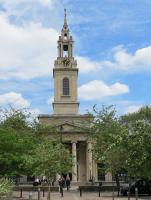
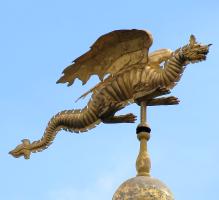
Thomas Guy and King Alfred statues.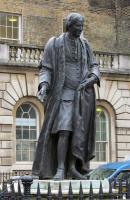
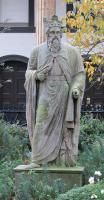
There are only a few in the area, but two are significant. Both are to the west in the Borough High Street area. In the courtyard of Guy’s Hospital is the statue of the founder, Thomas Guy (see this page), by the great sculptor Scheemakers, and in Trinity Church Square is a statue of King Alfred, sometimes called the oldest public statue in London, as it may be a medieval work from St Stephen’s Hall, Westminster, but it could also be a lost 18th Century statue of Alfred by Michael Rysbrack, contemporary of Scheemakers and just as important.
War Memorials: Lindsay Clarke's soldier and Arild Rosenkrantz's Christ.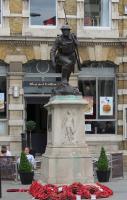
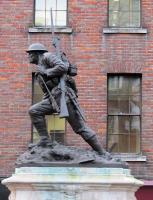
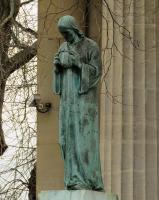
Also in the area are four 20th Century works. In Borough High Street itself is P. Lindsay Clark’s statue of soldier on the Borough World War I Memorial. To the east, on Tooley Street, are the statue of Bevington by Samuel March (1911), and a bust of Ernest Bevin by E. Whitney Smith, dating from the 1950s. And back in Burgess Park, outside the former Church of St George Wells Way which we have already noted, is a rare Danish sculpture, being a figure of Christ dating from the 1920s (picture above right) - see bottom of this page.
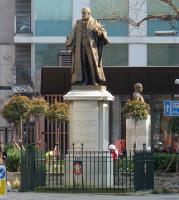 Bevington and Bevin, Tooley Street.
Bevington and Bevin, Tooley Street.
The older part of Guy’s Hospital dates from the 1770s, and has a pediment, two statues and cherubs by the important sculptor John Bacon the Elder. Nearby in Borough High Street, 19th Century architectural sculpture can be found in the pediment of the Hop Exchange, and as a terra cotta frieze on a hop factor’s building - both can be seen on the Borough High Street page. Not far off is the original little premises of the sculptural firm of E.J. and A.T. Bradford, alas without any decorative ornament.
Architectural sculpture: Guy's Hospital, Hop Exchange, Hop factors.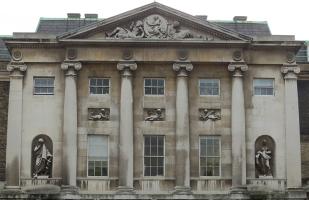
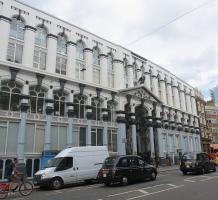
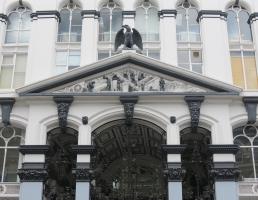
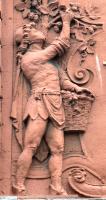
To the east in Bermondsey, the former Old Library of 1891 is a splendid late Victorian building with a fine pair of statues, very high up, and next to it is an almost undecorated Classical Deco building put up as municipal offices, and at one time acting as Bermondsey Town Hall. Just round the corner is the 1860s entrance to the Alaska Factory, with a carving of a seal indicating the fur trade which was the occupation of the owners - all these can be seen on this page.
Southwards to Walworth Road, where there is another good group, including the 1930s Health Centre, which has upon it statues by the firm of E.J. and A.T. Bradford whose premises we noted above, and next to it, the fine mid-Victorian Southwark Municipal Offices with carved foliage, heads, and minor decoration. And in Burgess Park again, we have another characteristic type of South London building, built by the philanthropist Passmore Edwards to house a library and public baths – this too has figure sculpture and carved panels.
Architectural sculpture, Queen Anne revival: Bermondsey, Walworth Road, Wells Road.
There are interesting things to west and east of the Borough-Bermondsey area. To the west of Walworth Road are:
London churches // Architecture pages
Visits to this page from 22 May 2016: 6,499